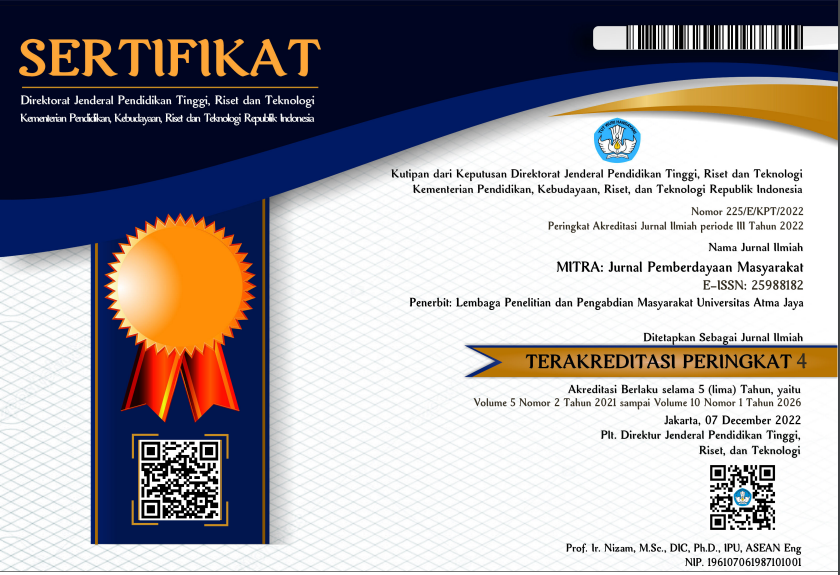The Production of Roasted Peanuts Using the Semi-Mechanical Roaster in Keranggan Village
DOI:
https://doi.org/10.25170/mitra.v6i1.3049Keywords:
semi-mechanical roaster, quality of roasted beans, mentoringAbstract
Roasted peanuts typically have a unique taste with a distinctive roasted aroma and a savory flavor different from peanuts processed using an oven. To make roasted peanuts, two critical stages should be observed: the sanitation during washing and the roasting technology. The current study focuses on the application of roasting technology in the production of roasted peanuts among the households in Keranggan Village, Setu District, South Tangerang City. It was an issue that the household scale manufacturing of roasted peanuts there did not meet the standard process, relying on manpower to monitor when the roasting process should end even though fatigued workers may produce burnt peanuts up to 19%. Therefore, to reduce the percentage of burnt peanuts, a semi-mechanical roasted fryer was developed for the roasted peanut entrepreneurs in Keranggan Village, Setu District, South Tangerang City. The research team conducted socialization of effective roasting technology, provided assistance, and delivered the semi-mechanical roasters to the community. The team also performed a direct test on the semi-mechanical roaster at both the Indonesian Institute of Technology laboratory and Keranggan Village, in addition to providing assistance on how to use the tool. The semi-mechanical roaster itself is made of stainless steel with a diameter of 100 cm, equipped with a stirrer powered by an electric motor capable of roasting automatically within a certain time limit. This will produce a homogeneous heat transfer with the sand media, which is not changed in line with the original roasting method. The lab and field trials showed that the burnt yield decreased to 5%. Furthermore, when compared to those produced through manual roasting, the sensory test of the products, showed results that were not significantly different even with a sensory value of appearance (i.e., the color) higher than that of manual roasting.
References
Ariyanti, S., Soekardi, C., & Taruna, R. (2017). Rancang bangun mesin penyangrai kacang tanah pada industri mochi di Sukabumi. Jurnal Energi dan Manufaktur,10(2), 53–59.
Batas, F. C., Rengkung, L. R., & Mandei, J. R. (2020). Analisis nilai tambah kacang sangrai UD. Merpati di Desa Tombasian Atas Kecamatan Kawangkoan Barat. AgriSosioekonomi, 16(2), 189.
https://doi.org/10.35791/agrsosek.16.2.2020.28745.
Buckholz Jr., L. L., Daun, H., Stier, E., & Trout, R. (1980). Influence of roasting time on sensory attributes of fresh roasted peanuts. Journal of Food Science, 45(3), 547–554. https://doi.org/https://doi.org/10.1111/j.1365-2621.1980.tb04098.x.
Dwiaji, Y. C., & Sulistyowati, N. (2021). Program kemitraan masyarakat home industry kacang sangrai Desa Cisoka Kabupaten Tangerang. Indonesia Berdaya, 2(2), 149–155. https://doi.org/https://doi.org/10.47679/ib.2021129.
Fliedner, I., & Wilhelmi. (1993). Grundlagen pruefverfahren der lebensmittelsensorik. Behr Verlag Berlin.
Leonita, S., Harta, G. D. M., Octasylva, A. R. P., & Irianto, H. (2020). Analisis kelayakan tekno-ekonomi produk agroindustri kacang lurik sangrai di Kota Tangerang Selatan. Jurnal IPTEK, 4(1), 33–39. https://doi.org/10.31543/jii.v4i1.156.
Marais, M., Conradie, N., & Labadarios, D. (2007). Small and micro enterprises - Aspects of knowledge, attitudes and practices of manager’s and food handlers’ knowledge of food safety in the proximity of Tygerberg Academic Hospital, Western Cape. South African Journal of Clinical Nutrition, 20(2), 50–61. https://doi.org/10.1080/16070658.2007.11734124.
Mardikanto, T., & Poerwoko, S. (2012). Pemberdayaan masyarakat dalam perspektif kebijakan publik. Alpha Betha.
McGranahan, G., & Mitlin, D. (2016). Learning from sustained success: How community-driven initiatives to improve urban sanitation can meet the challenges. World Development, 87, 307–317. https://doi.org/10.1016/j.worlddev.2016.06.019.
Miltin, D. (2016). Develovment and corporation (F. Z. (all K. Dr Solveig Buhl, Klaus Gihr (ed.)). KfW, a public law institution. https://www.dandc.eu/en/article/communitybased-data-collection-helps-residents-informal-settlements-fight-their-interests.
Sari, S. A., Hutabarat, J., La, S., & Indriani, S. (2019). Penerapan mesin roaster kacang tanah untuk peningkatan produksi pada home industry kacang goreng. Teknologi dan Manajemen Industri, 5(2), 25–28.
Downloads
Published
Issue
Section
License
This license allows reusers to distribute, remix, adapt, and build upon the material in any medium or format for noncommercial purposes only, and only so long as attribution is given to the creator. If you remix, adapt, or build upon the material, you must license the modified material under identical terms.



_.jpeg)

.png)
2.png)
.png)
.png)



